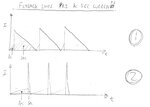aj_augus
Newbie level 6
Hi,
Can anyone help with materials for the designing of LED drivers (Home applications). Transformer design values such as Primary inductance....etc. I referred so many equations, each of them looks different and as there are different modes, DCM,CCM, and different ICs, I am totally confused with the calculations.
Please help
I have got a transformer design with equations for PSR, DCM transformer design. I don't know what are the parameters different from DCM from BCM design. As my IC is working with Critical Conduction Mode(It is also called BCM I guess).
Can anyone help with materials for the designing of LED drivers (Home applications). Transformer design values such as Primary inductance....etc. I referred so many equations, each of them looks different and as there are different modes, DCM,CCM, and different ICs, I am totally confused with the calculations.
Please help
--- Updated ---
I have got a transformer design with equations for PSR, DCM transformer design. I don't know what are the parameters different from DCM from BCM design. As my IC is working with Critical Conduction Mode(It is also called BCM I guess).
Last edited:
